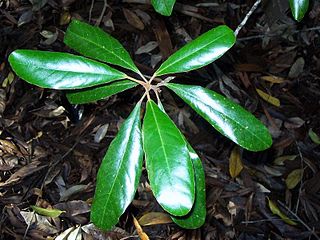
Elaeocarpus williamsianus, commonly known as hairy quandong, is a species of flowering plant in the family Elaeocarpaceae and is endemic to a restricted area of north-eastern New South Wales. It is a small tree with lance-shaped leaves, racemes of greenish-white flowers and spherical blue fruit.

Olearia floribunda, commonly known as heath daisy-bush, is a species of flowering plant in the family Asteraceae.

Prostanthera stenophylla is a species of flowering plant in the family Lamiaceae and is endemic to Wollemi National Park in New South Wales. It is an erect, slender, aromatic shrub with hairy, oblong leaves and small groups of pale bluish mauve to violet flowers.

Hibbertia miniata, commonly known as orange flower, is a small shrub in the family Dilleniaceae and is endemic to Western Australia.
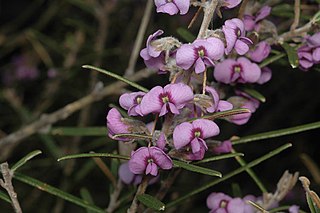
Hovea rosmarinifolia, commonly known as mountain beauty or rosemary hovea is a shrub in the family Fabaceae, native to Australia. A small shrub bearing attractive blue-purple or mauve pea flowers from August to November.

Boronia hapalophylla is a plant in the citrus family Rutaceae and is endemic to New South Wales. It is an erect or straggling shrub with simple leaves, hairy branches and relatively large pink, four-petalled flowers.
Olearia aglossa, is a shrub in the family Asteraceae and is found in mountainous terrain in New South Wales and Victoria in Australia. It is a small shrub with spreading upright branches and white daisy-like flowers.

Epacris sparsa, is a small upright shrub with creamy-white flowers, elliptic to egg-shaped leaves and reddish new growth. It is endemic to New South Wales with a restricted distribution.

Androcalva rosea, commonly known as Sandy Hollow commersonia, is a small endangered shrub with pink flowers and prostrate trailing branches. It is only known from four locations in the Hunter Valley of New South Wales.

Leptospermum barneyense is a species of shrub that is endemic to the Mount Barney National Park in Queensland. It has rough, fibrous bark, young branches with conspicuous flanges, lance-shaped leaves, white or pink flowers and hemispherical fruit.
Leptospermum benwellii is a species of shrub that is endemic to the Nymboida National Park in New South Wales. It has smooth bark, young branches with conspicuous flanges, narrow elliptical leaves, white flowers and thin-walled, bell-shaped to hemispherical fruit.
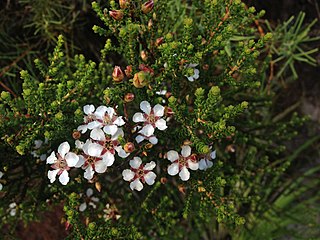
Leptospermum epacridoideum is a species of plant that is endemic to a restricted area of the South Coast of New South Wales. It is a bushy shrub with compact bark, elliptical to more or less circular leaves, white flowers arranged singly on short axillary side shoots, and woody fruit.
Leionema ceratogynum is a dense shrub, it grows on the south coast of New South Wales, Australia. It has oval-elliptic shaped leaves, scented foliage and lemon flowers usually in groups of three arising from the leaf axils.

Leptospermum namadgiense is a species of small shrub that is endemic to areas near the border between New South Wales and the Australian Capital Territory. It has silky-hairy, narrow lance-shaped to elliptical leaves, usually white flowers borne singly or in pairs on short side shoots, and fruit that falls from the plant shortly after the seeds are released.

Phebalium bifidum is a species of small, erect shrub that is endemic to the Capertee Valley in New South Wales. It is more or less covered with glossy scales and has bilobed leaves and cream-coloured to bright yellow flowers arranged in umbels on the ends of branchlets.
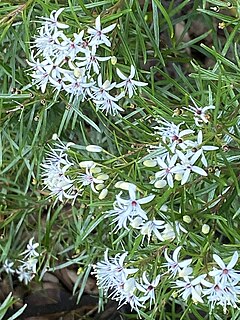
Leionema praetermissum, is a shrub with warty stems covered in hairs, white flowers with spreading petals, and prominent stamens. It has a restricted distribution in New South Wales.
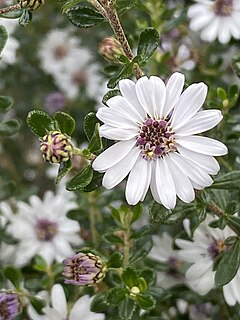
Olearia minor, is a small flowering shrub in the family Asteraceae. It has alternate leaves and white to pale mauve daisy-like flowers from winter to December. It grows in Western Australia, South Australia, New South Wales, and Victoria.

Commersonia amystia is a species of flowering plant in the family Malvaceae and endemic to eastern Australia. It is a dwarf shrub with narrow egg-shaped leaves that are densely covered with star-like hairs on the lower surface, and has flowers with five white sepals that turn pink as they age, and five smaller white petals.
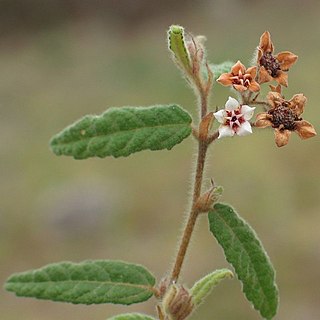
Commersonia breviseta is a species of flowering plant in the family Malvaceae and endemic to eastern Australia. It is a dwarf shrub with densely-hairy, egg-shaped to narrow elliptic leaves that are paler on the lower surface, and flowers with five white sepals with pink edges, five smaller pale yellow petals and dark red stamens.
Hibbertia acaulothrix is a species of flowering plant in the family Dilleniaceae and is endemic to New South Wales. It is an erect shrub with lance-shaped leaves and yellow flowers arranged singly, with nine to thirteen stamens arranged around the carpels.
















